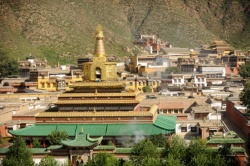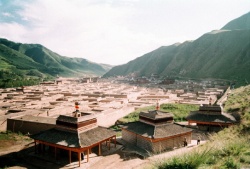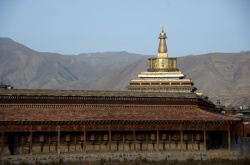Labrang Monastery
- For Labrang Monastery in Sikkim see Labrang Monastery (Sikkim)
Labrang Monastery (Tibetan: བླ་བྲང་བཀྲ་ཤིས་འཁྱིལ་ Wylie: bla-brang bkra-shis-'khyil; Chinese: 拉卜楞寺 Pinyin: lābǔlèng sì) is one of the six great Monasteries of the Geluk (Yellow Hat) school of Tibetan Buddhism. Its formal Name is: Gandan Shaydrup Dargay Tashi Gyaysu Khyilway Ling (dGe ldan bshad sgrub dar rgyas bkra shis gyas su 'khyil ba'i gling), commonly known as Labrang Tashi Khyil, or simply Labrang.
Labrang is located in Xiahe County in Gansu province, in the traditional Tibetan area of Amdo. Labrang Monastery is home to the largest number of Monks outside of Tibet Autonomous Region. Xiahe is located about 4 hours from the city of Lanzhou, the capital of Gansu.
In the early part of the 20th century, Labrang was by far the largest and most influential Monastery in Amdo. It is located on the Sangchu or Xiahe River a tributary of the Huang He or Yellow River.
Labrang Monastery is located in the town of Xiahe, which belongs to the Gannan Tibetan Autonomous Prefecture.
History
The Monastery was founded in 1709 by the first Jamyang Zhaypa, Ngawang Tsondru. It is Tibetan Buddhism's most important Monastery town outside the Tibetan Autonomous Region.
Labrang Monastery is situated at the strategic intersection of four major Asian cultures—Tibetan, Mongolian, Han Chinese, and Chinese Muslim—was one of the largest Buddhist monastic universities. In the early 20th century, it housed several thousand Monks. Labrang was also a gathering point for numerous annual religious festivals, supported an active regional marketplace where Han Chinese artisans rubbed shoulders with Hui merchants and nomadic Tibetan highlanders, and was the seat of a Tibetan Power base that strove to maintain regional autonomy through the shifting alliances and bloody conflicts that took place between 1700 and 1950.
In April 1985 the Assembly Hall burned down. It was replaced and the new building was consecrated in 1990.
Description
The Monastery complex dominates the northern part of the village. The white walls and golden roofs feature a blend of Tibetan and Han architectural styles. The Monastery contains 18 halls, six institutes of learning, a golden Stupa, a Sutra debate area, and houses nearly 60,000 Sutras. There once were more than 2,000 Monks in residence, but now only about 1,000, due to a twelve year closure starting in 1958. It has a Buddhist museum with a large collection of Buddha statues, Sutras and murals. In addition, a large amount of Tibetan Language Books, including Books on history is available for purchase, together with medicines, calendars, Music and Art objects.
There used to be a great golden statue of The Buddha, more than 50 feet high, which was surrounded by rows of surrounding Buddhas in niches.
The Monastery today is an important place for Buddhist ceremonies and Activities. From January 4 to 17 and June 26, to July 15, (these dates may change according to the lunar Calendar), the great Buddhist ceremony will be held with Buddha-unfolding, Sutra enchanting, praying, Sutra Debates, etc.
Muslim Ma clique attacks on Labrang
The Chinese Muslim Ma Clique under Generals Ma Qi and Ma Bufang launched several attacks against Labrang as part of a general anti Ngolok Tibetan campaign.
Ma Qi occupied Labrang Monastery in 1917, the first Time non-Tibetans had seized it. Ma Qi defeated the Tibetan forces with his Hui Chinese troops. His forces were praised by foreigners who traveled through Qinghai for their fighting abilities.
After ethnic rioting between Hui and Tibetans emerged in 1918, Ma Qi defeated the Tibetans. He heavily taxed the town for 8 years. In 1925, a Tibetan rebellion broke out, with thousands of Tibetans driving out the Hui. Ma Qi responded with 3,000 Hui Chinese troops, who retook Labrang and machine gunned thousands of Tibetan Monks as they tried to flee. During a 1919 attack by Muslim forces, Monks were executed by burning. Bodies were left strewn around Labrang by the Hui troops.
Ma Qi besieged Labrang numerous Times, the Tibetans fought against his Hui forces for control of Labrang, until Ma Qi gave it up in 1927. However, that was not the last Labrang saw of General Ma. Ma Qi launched a genocidal War against the Tibetan Ngoloks, in 1928, inflicting a defeat upon them and seizing the Labrang Buddhist Monastery. The Hui forces looted and ravaged the Monastery again.
The Austrian American explorer Joseph Rock encountered the aftermath of one of the Ma clique's campaigns against Labrang. The Ma Muslim army left Tibetan skeletons scattered over a wide area, and the Labrang Monastery was decorated with decapitated Tibetan heads. After the 1929 battle of Xiahe near Labrang, decapitated Tibetan heads were used as ornaments by Chinese Muslim troops in their camp, 154 in total. Rock described "young girls and children"'s heads staked around the military encampment. Ten to fifteen heads were fastened to the saddle of every Muslim cavalryman. The heads were "strung about the walls of the Moslem garrison like a garland of Flowers."
Recent events
In March 2008 there were protests by Monks from Labrang Monastery as well as by other ethnic Tibetans linked to previous protests and rioting that broke out in Lhasa.


